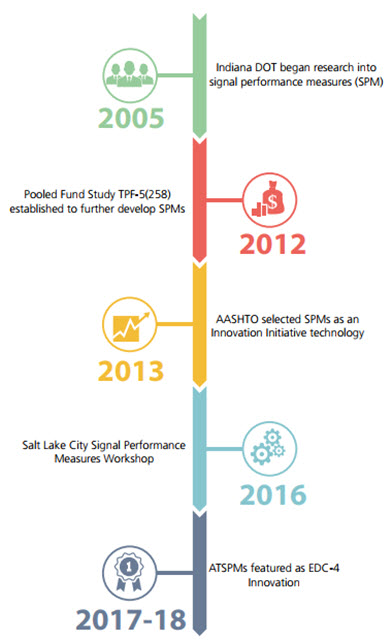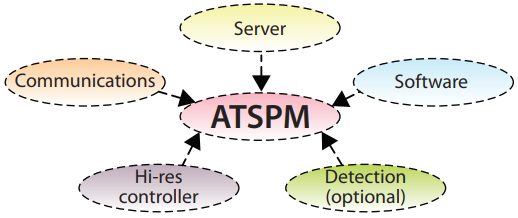Automated Traffic Signal Performance MeasuresWhat are Automated Traffic Signal Performance Measures?Automated traffic signal performance measures are a collection of data analytics tools and approaches that automatically collect and convert high-resolution traffic controller data into actionable performance measures. There are more than 330,000 traffic signals operating in the United States, and highway agencies typically retime these signals on a three- to five-year cycle at a cost of approximately $4,500 per intersection.1 For many of these signals, citizen complaints are the primary measure of performance. Since performance data is not continuously collected at most intersections, intersection performance is simulated using software models based on periodic and manual traffic data collection, which adds cost and time to the signal retiming process. When agency professionals and consultants conduct traditional retiming projects, they must often perform an ad hoc comparison of before and after travel-time data to demonstrate the effectiveness of optimization efforts. Typically, no ongoing performance measurement capability exists and agencies must rely on citizen complaints to reactively detect maintenance or operational deficiencies. This lack of active performance management can compromise safety and efficiency and contribute to congestion. Improving Traffic Congestion Through Objectives-based SolutionsTraditional traffic signal retiming programs follow a linear, project-based process. The process starts with a triggering event, such as a customer complaint or an intersection reaching its three- to five-year retiming schedule. It then enters a design phase where volume and turning movement data is collected and analyzed with a simulation model. The resulting timing parameters are then implemented in the field, fine-tuned based on observations, and evaluated to determine the level of improvement. At this point, the process is complete and attention is only paid to the intersection if another triggering event occurs (sometimes years later). An objectives- and performance-based traffic signal program follows a more operations-based approach. After establishing traffic signal program objectives based on agency goals and context, performance measures are identified and continuously used to monitor the effectiveness of strategies and tactics. Corrective action does not wait until external triggers compel change. Instead, agencies initiate corrective actions based on performance measures and do so before external triggers come into play. Automated traffic signal performance measures (ATSPM) are an enabling technology that leverages data collection and analysis for proactive traffic signal system management. However, if the full benefits of ATSPM are to be realized, agencies should be willing to adopt business processes that institutionalize regular performance monitoring and that take prompt action when traffic signal issues are identified. Why use Automated Traffic Signal Performance Measures?The Federal Highway Administration (FHWA) promoted ATSPM in round four of Every Day Counts as a means to improve on traditional retiming processes through continuous performance monitoring. Using ATSPM, signal retiming efforts can be based directly on actual performance and continually collected data, significantly reducing the level of effort, time, and cost involved in providing effective traffic signal operations. ATSPM consist of a high-resolution data-logging capability added to existing traffic signal infrastructure and data analysis techniques that provides agency professionals with information needed to proactively identify and correct deficiencies. They can then manage traffic signal maintenance and operations in support of their safety, livability, and mobility goals.  Figure: Traditional vs. Objectives-based Solutions
Figure: Traditional vs. Objectives-based SolutionsSource: FHWA ATSPM technology is cost-effective, as it can be applied to a wide range of signalized intersections and use existing infrastructure to the greatest extent possible. ATSPM can also support the validation of other technologies and operational strategies, such as adaptive signal control and emerging connected vehicle applications.  Figure: ATSPM Technology Timeline
Figure: ATSPM Technology TimelineSource: FHWA EDC Identified Benefits(https://www.fhwa.dot.gov/innovation/everydaycounts/edc_4/atspm.cfm)
Collaborative Research and ImplementationATSPM technology is the outcome of a collaboration among FHWA, the American Association of State Highway and Transportation Officials, state departments of transportation (DOT), and academic research efforts. A Transportation Pooled Fund study, Traffic Signal Systems Operations and Management, led by the Indiana DOT with participation from the FHWA, 11 state DOTs, and the City of Chicago, produced an open-source software option that provides a framework for continued innovation in data analysis techniques. Automated Traffic Signal Performance Measures in a NutshellATSPMs automatically collect and convert high-resolution traffic controller data into actionable performance measures. Data and performance measures are based on the Indiana DOT high-resolution data enumerations,2 allowing them to be implemented with any type of traffic signal system that supports high-resolution data logging.  Figure: Data collection and performance information
Figure: Data collection and performance informationSource: FHWA  Figure: Five basic ATSPM system components
Figure: Five basic ATSPM system componentsSource: FHWA An ATSPM system is typically made up of five basic components: High-Resolution Controller: each time the traffic signal controller receives an input (e.g. from a detector) or generates an output (e.g. changes the phase of a signal), the controller logs the event and its timestamp in a high-resolution data log. Events are logged using standardized codes called "enumerations." Communications: a method of communication is needed to move high-resolution traffic log information from the controller to a central server for processing. Communications can either be persistent (like a fiber connection), periodic (like a dial-up connection), or manual (data obtained by field technician). Server: A central server is needed to store and aggregate the high-resolution traffic data. Software: Special ATSPM software is used to analyze the aggregated high-resolution traffic data and produce automated performance measures reports. Detection (optional): Basic ATSPM functionality can be achieved without vehicle detection, such as analysis of green times. However, intersections with vehicle detection can benefit from more advanced capabilities such as phase utilization and offset optimization. ATSPM ImplementationsThree main types of ATSPM implementations have emerged to date.
|
|
United States Department of Transportation - Federal Highway Administration |
||